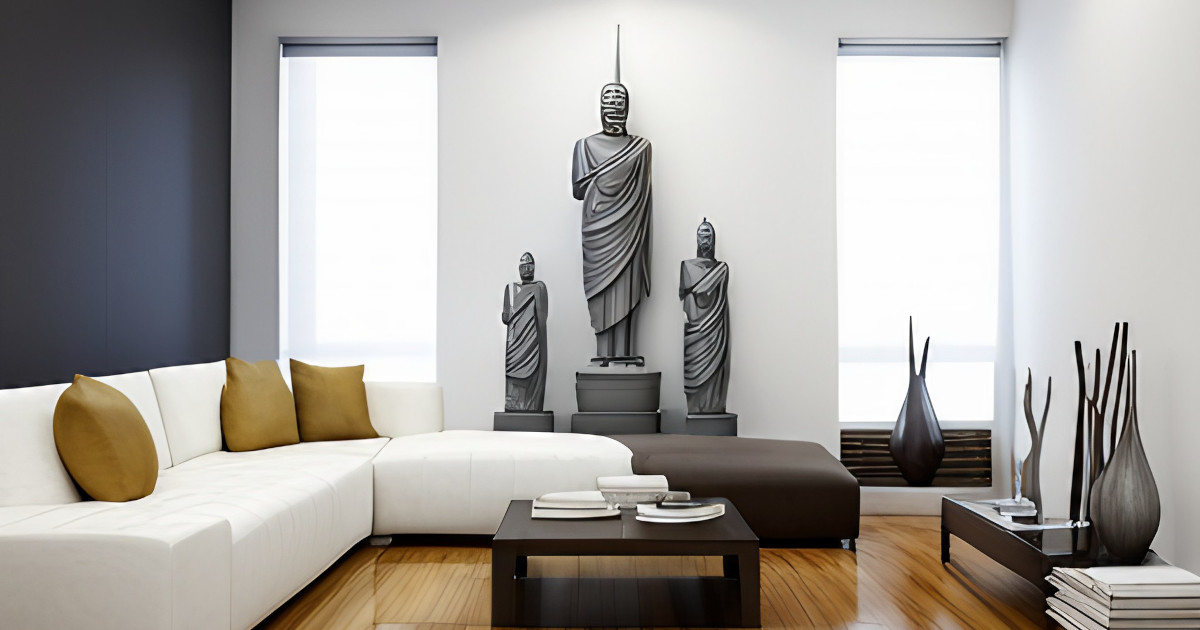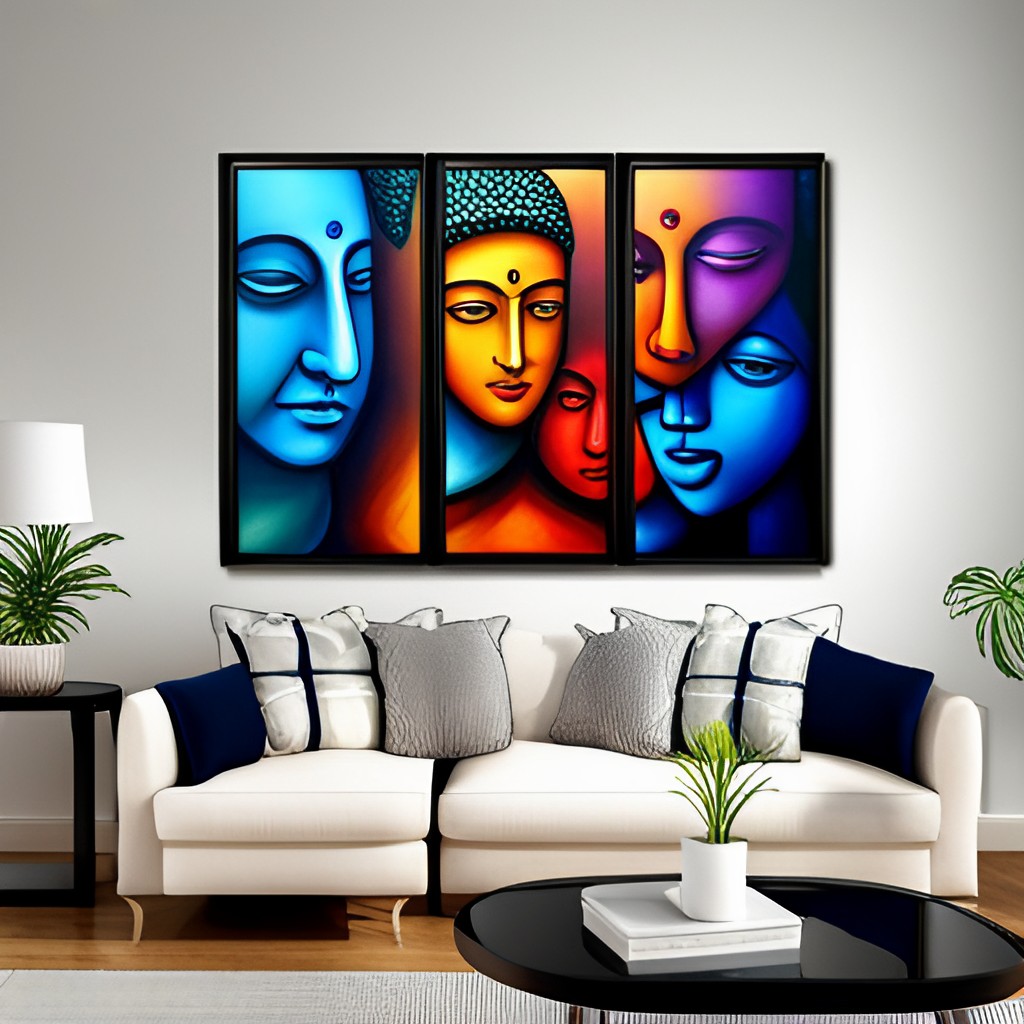
Religious Statues and Their Place in Modern Indian Homes
In the rich tapestry of Indian culture, religion, and spirituality are threads that run deep. They manifest in many forms, including the presence of religious statues in homes. These statues serve not only as symbols of faith but also as integral elements of home decor.
The Historical Context of Religious Statues in Indian Homes
Discover the rich tradition of religious sculptures in Indian culture, a lasting legacy spanning century. The Metropolitan Museum of Art reveals that these exquisite works of art are intricately linked to the worship of deities, offering a profound connection to the divine.
Indian religious sculptures provide comprehensive insight into the history and culture of the sub-continent. These sculptures, often depicting abstracted human forms, were used to instruct people in the truths of the Hindu, Buddhist, or Jain religions. The female nude, in particular, was used both to represent the body as a symbol of spirit and to reveal the imagined shapes of the gods.
During the medieval period, Indian culture gave great importance to sculpture, decorating both North and South Indian temples with intricate works of art, bronze statues provided a physical form for the myriad gods and unseen forces that shared their world.
It’s important to note that Hindus don’t worship idols, believing them to be Gods. Rather, they view the statues and images as physical representations of God to help them focus on aspects of prayer or meditation.
In today’s modern Indian homes, these statues continue to serve as symbolic reminders of faith while also contributing to the aesthetic appeal of the decor.
Types of Religious Statues Common in Indian Homes
In the rich tapestry of Indian culture, religious statues play a pivotal role. They are more than just decorative elements; they symbolize faith, spirituality, and centuries-old traditions. These statues, often depicting various Hindu deities, are not merely objects but revered embodiments of divine energy. From the intricately carved idols of Ganesha, the remover of obstacles, to the serene statuettes of Buddha, each piece holds profound significance. Let’s delve into the diverse world of religious statues that grace Indian homes, exploring their symbolism, artistry, and the unique ambiance they create.
Hinduism
Discover the vibrant world of Hinduism in India, where an array of gods and goddesses reign supreme. Explore the profound spiritual meaning behind the divine statues that grace this ancient religion. These intricately designed figures are far more than mere decorations, they represent profound beliefs and sacred traditions. Immerse yourself in the rich tapestry of Hinduism and unlock a deeper understanding of this captivating faith.
Lord Ganesha: Often found at entrances and prayer rooms, the statue of Lord Ganesha, the elephant-headed god, is considered auspicious1. Revered as the remover of obstacles and the lord of beginnings, he is worshipped before starting any task to ensure success and prosperity.
Lord Shiva: Representing the force of change and transformation, Lord Shiva is one of the principal deities of Hinduism. His statues often depict him in deep meditation or performing the cosmic dance of destruction and creation. These statues serve as a reminder of life’s impermanence and the cycle of birth, death, and rebirth.
Lord Hanuman: Statues of Lord Hanuman, the monkey god known for his strength and loyalty, are often found at the entrances of houses. Worshippers believe that he wards off evil and protects the home.
Buddhism

Discover the lasting impact of Buddhism in India’s northeastern states. Although Hinduism may reign supreme, the traces of Buddhist influence remain significant. Explore the cultural tapestry where ancient traditions still thrive.
The Buddha: The Buddha statue is a symbol of enlightenment and peace. The different postures and gestures (mudras) of Buddha statues have different meanings. For instance, a statue of the Buddha in a meditative pose can inspire introspection and tranquility.
Sikhism
Sikhism, another major religion in India, is unique in that it does not encourage idol worship. Therefore, you are unlikely to find religious statues in Sikh households. Instead, the focus is on the holy book, Guru Granth Sahib, which is regarded as the eternal Guru.
Integrating Religious Statues into Modern Home Decor
As interior design evolves, it continues to draw upon diverse influences, including faith and spirituality. One emerging trend is the integration of religious statues into modern home decor. This approach allows for a personal touch, reflecting the homeowner’s beliefs while adding a unique aesthetic element. However, it’s crucial to do this respectfully to avoid unintentional offense.
Choosing the Right Type of Religious Statues
The first step in integrating religious statues into your home decor is choosing the right ones. The type of statue you choose should not only align with your beliefs but also complement the overall theme of your home. For example, a bronze statue of Buddha might fit perfectly into a room with earthy tones and minimalist decor. Conversely, a brightly colored statue of Lord Ganesha could add a pop of color to a monochromatic room.
Each statue carries its energy and symbolism. For instance, a statue of Saint Francis of Assisi, known for his love for animals and nature, could bring a sense of peace and harmony to your space.
Positioning the Statues
Placement plays a crucial role in how these statues influence your home’s ambiance. Traditionally, many cultures place religious statues facing the entrance to ward off negative energy. In modern decor, you can place smaller statues on floating shelves or coffee tables as conversation pieces. Larger statues can be floor-standing, serving as striking focal points in a room.
Remember, the positioning should respect the statue’s religious significance. Some faiths have specific guidelines for displaying religious images and symbols, so it’s essential to be mindful of these when deciding on placement.
Creating a Dedicated Space
For those who use these statues for prayer or meditation, creating a dedicated spiritual corner can be beneficial. This space can house the statue, along with other elements like candles, incense, or scripture. A well-designed spiritual corner can serve as a peaceful retreat within your home, promoting mindfulness and relaxation.
Spotlight on Unique Religious Statues
The captivating world of religious statues – powerful cultural symbols crafted with artistic brilliance and steeped in centuries of faith and tradition. Beyond their significance as objects of reverence, these statues are veritable masterpieces that beautifully embody the beliefs, history, and aesthetic sensibilities of their creators. Embark on a journey to explore some of the most intriguing religious statues from around the globe in this enlightening article.
The Statue of Ganesha – India
The statue of Ganesha, the elephant-headed deity revered as the remover of obstacles, is a significant symbol in Hinduism. Made from various materials like stone, metal, or clay, these statues often depict Ganesha seated with one of his feet resting on the ground and the other bent at the knee, a pose indicating both the physical and spiritual realms1. These statues play a central role in the Ganesh Chaturthi festival, where they are paraded through the streets before being immersed in water.
The Great Buddha of Kamakura – Japan
Crafted in bronze, the Great Buddha of Kamakura stands over 13 meters tall and is a testament to Japanese craftsmanship and devotion. This statue represents Amida Buddha, who is believed to aid all beings in achieving enlightenment. It’s a serene expression and meditative posture has drawn both worshippers and art enthusiasts for centuries.
Christ the Redeemer – Brazil
Overlooking the city of Rio de Janeiro, the Christ the Redeemer statue is an iconic symbol of Christianity. Created using reinforced concrete clad in a mosaic of triangular soapstone tiles, this statue stands 30 meters tall, not including its 8-meter pedestal. The statue’s open-armed design represents peace and serves as a beacon of faith for millions.
The Sphinx – Egypt
While not representative of a specific deity, the Sphinx is a crucial figure in Egyptian mythology. Carved out of limestone, this monolithic statue depicting a lion’s body with a human head is believed to symbolize royal power and divine wisdom4. Despite the erosion of time, it continues to intrigue archaeologists and tourists alike.
The Impact of Religious Statues on the Atmosphere of a Home
Religious statues, an integral part of cultural and religious practices for centuries, have been more than just decorative elements in homes. They serve as symbols of faith, embodying divine energy and spiritual significance that can profoundly impact the atmosphere of a home.
Common Types of Religious Statues in Homes
From Hindu deities to Christian saints, and Buddhist figures to Islamic calligraphy panels, religious art takes various forms across different cultures.
In Hindu households, it’s common to find statues of deities such as Lord Ganesha, known as the remover of obstacles, or Goddess Lakshmi, symbolizing prosperity and wealth. These figures, often crafted from brass, marble, or clay, are not only aesthetically pleasing but also hold deep spiritual meanings.
Christian homes frequently feature crucifixes and statues of Jesus Christ, the Virgin Mary, and various saints. These pieces, often made from wood, resin, or porcelain, serve as reminders of faith and devotion.
Buddhist households might display statues of Buddha in various mudras (gestures), each representing different aspects of the path toward enlightenment. These statues, usually crafted from stone, metal, or wood, inspire mindfulness and serenity.
Impact of Religious Statues on the Home Atmosphere
Create a sacred ambiance in your home with religious statues that will evoke feelings of comfort, hope, tranquility, and peace. These unique pieces serve as focal points for prayer or meditation, fostering a deep sense of spirituality within your house.
For example, a statue of Buddha radiates calm and introspection, while a statue of Ganesha brings a sense of auspiciousness and positivity. A crucifix or a statue of Jesus Christ offers a profound feeling of divine love and forgiveness.
Not only do these statues enhance your home’s atmosphere, but they also spark meaningful conversations. Discover the power and beauty of religious statues and enrich your living space with their spiritual significance.
Conclusion
Religious statues in Indian homes serve as more than just art or decoration. They are powerful symbols of faith, spirituality, and a rich cultural heritage that permeates day-to-day life. Each figure, be it a respected deity or an important spiritual icon, bears deep-seated symbolism and historical importance. These statues not only enrich the home with a serene ambiance but also act as a silent testament to India’s diverse religious practices and beliefs. As enduring elements of Indian households, they offer a unique lens through which we can appreciate the country’s vibrant traditions and spiritual richness.
